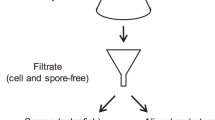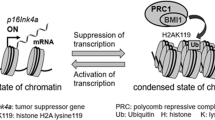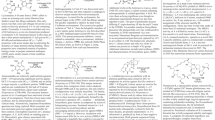Abstract
Soil microorganisms are rich sources of bioactive natural products. Interspecies interactions are the cues of their production and refine biological activities. These interactions in natural environments include the interplay between microorganisms and Metazoans (animals), such as nematodes, insects, and ticks. Chemical intercellular communication modulators could exert ideal Metazoan-selective toxicity for defending microorganisms. Developmental signaling pathways, such as the Notch, TGF-beta, and Wnt pathways, are intercellular communication networks that contribute to the reproducible formation of complex higher-order Metazoan body structures. Natural modifiers of the developmental signaling pathway are attractive therapeutic seeds for carcinoma and sarcoma treatment. However, these fundamental signaling pathways also play indispensable physiological roles and their perturbation could lead to toxicity, such as defects in stem cell physiology and tissue regeneration processes. In this review, we introduce a screening system that selects developmental signaling inhibitors with wide therapeutic windows using zebrafish embryonic phenotypes and provide examples of microorganism-derived Wnt pathway inhibitors. Moreover, we discuss safety prospects of the developmental signaling inhibitors.
This is a preview of subscription content, access via your institution
Access options
Subscribe to this journal
Receive 12 print issues and online access
$259.00 per year
only $21.58 per issue
Buy this article
- Purchase on Springer Link
- Instant access to full article PDF
Prices may be subject to local taxes which are calculated during checkout






Similar content being viewed by others
References
Waksman SA. Antagonistic relations of microorganisms. Bacteriol Rev. 1941;5:231–91.
Davies J, Spiegelman GB, Yim G. The world of subinhibitory antibiotic concentrations. Curr Opin Microbiol. 2006;9:445–53.
Yim G, Wang HH, Davies J. Antibiotics as signalling molecules. Philos Trans R Soc Lond B Biol Sci. 2007;362:1195–200.
Romero D, Traxler MF, Lopez D, Kolter R. Antibiotics as signal molecules. Chem Rev. 2011;111:5492–505.
Yim G, McClure J, Surette MG, Davies JE. Modulation of Salmonella gene expression by subinhibitory concentrations of quinolones. J Antibiot. 2011;64:73–8.
Young IM, Crawford JW. Interactions and self-organization in the soil-microbe complex. Science. 2004;304:1634–7.
O’Donnell AG, Young IM, Rushton SP, Shirley MD, Crawford JW. Visualization, modelling and prediction in soil microbiology. Nat Rev Microbiol. 2007;5:689–99.
Quince C, Curtis TP, Sloan WT. The rational exploration of microbial diversity. ISME J. 2008;2:997–1006.
Crawford JW, Harris JA, Ritz K, Young IM. Towards an evolutionary ecology of life in soil. Trends Ecol Evol. 2005;20:81–7.
Trevors JT. One gram of soil: a microbial biochemical gene library. Antonie Van Leeuwenhoek. 2010;97:99–106.
Bardgett RD, van der Putten WH. Belowground biodiversity and ecosystem functioning. Nature. 2014;515:505–11.
van den Hoogen J, Geisen S, Routh D, Ferris H, Traunspurger W, Wardle DA, et al. Soil nematode abundance and functional group composition at a global scale. Nature. 2019;572:194–8.
Crowther TW, Boddy L, Jones TH. Species-specific effects of soil fauna on fungal foraging and decomposition. Oecologia. 2011;167:535–45.
Ferris H. Contribution of nematodes to the structure and function of the soil food web. J Nematol. 2010;42:63–7.
Grosberg RK, Strathmann RR. The evolution of multicellularity: a minor major transition? Annu Rev Ecol, Evolution, Syst. 2007;38:621–54.
Hoffmeyer TT, Burkhardt P. Choanoflagellate models—Monosiga brevicollis and Salpingoeca rosetta. Curr Opin Genet Dev. 2016;39:42–7.
Fairclough SR, Dayel MJ, King N. Multicellular development in a choanoflagellate. Curr Biol. 2010;20:R875–6.
Richter DJ, King N. The genomic and cellular foundations of animal origins. Annu Rev Genet. 2013;47:509–37.
Hehenberger E, Tikhonenkov DV, Kolisko M, Del Campo J, Esaulov AS, Mylnikov AP, et al. Novel predators reshape holozoan phylogeny and reveal the presence of a two-component signaling system in the ancestor of animals. Curr Biol. 2017;27:2043–50 e2046.
Sebe-Pedros A, Irimia M, Del Campo J, Parra-Acero H, Russ C, Nusbaum C, et al. Regulated aggregative multicellularity in a close unicellular relative of metazoa. Elife. 2013;2:e01287.
Artavanis-Tsakonas S, Rand MD, Lake RJ. Notch signaling: cell fate control and signal integration in development. Science. 1999;284:770–6.
Radtke F, Raj K. The role of Notch in tumorigenesis: oncogene or tumour suppressor? Nat Rev Cancer. 2003;3:756–67.
Schweisguth F. Regulation of Notch signaling activity. Curr Biol. 2004;14:R129–38.
Özbek S, Balasubramanian PG, Chiquet-Ehrismann R, Tucker RP, Adams JC. The evolution of extracellular matrix. Mol Biol Cell. 2010;21:4300–5.
Hynes RO. The extracellular matrix: not just pretty fibrils. Science. 2009;326:1216–9.
assagué J, Chen YG. Controlling TGF-beta signaling. Genes Dev. 2000;14:627–44.
Moroz LL, Kocot KM, Citarella MR, Dosung S, Norekian TP, Povolotskaya IS, et al. The ctenophore genome and the evolutionary origins of neural systems. Nature. 2014;510:109–14.
Ryan JF, Pang K, Mullikin JC, Martindale MQ, Baxevanis AD, Program NCS. The homeodomain complement of the ctenophore Mnemiopsis leidyi suggests that Ctenophora and Porifera diverged prior to the ParaHoxozoa. EvoDevo. 2010;1:9.
Loh Kyle M, van Amerongen R, Nusse R. Generating cellular diversity and spatial form: Wnt signaling and the evolution of multicellular animals. Developmental Cell. 2016;38:643–55.
Adamska M, Degnan SM, Green KM, Adamski M, Craigie A, Larroux C, et al. Wnt and TGF-β Expression in the Sponge Amphimedon queenslandica and the Origin of Metazoan Embryonic Patterning. PLOS ONE. 2007;2:e1031.
Srivastava M, Begovic E, Chapman J, Putnam NH, Hellsten U, Kawashima T, et al. The Trichoplax genome and the nature of placozoans. Nature. 2008;454:955–60.
Hobmayer B, Rentzsch F, Kuhn K, Happel CM, von Laue CC, Snyder P, et al. WNT signalling molecules act in axis formation in the diploblastic metazoan Hydra. Nature. 2000;407:186–9.
Wikramanayake AH, Hong M, Lee PN, Pang K, Byrum CA, Bince JM, et al. An ancient role for nuclear β-catenin in the evolution of axial polarity and germ layer segregation. Nature. 2003;426:446–50.
Takada R, Satomi Y, Kurata T, Ueno N, Norioka S, Kondoh H, et al. Monounsaturated fatty acid modification of Wnt protein: its role in Wnt secretion. Developmental Cell. 2006;11:791–801.
Willert K, Brown JD, Danenberg E, Duncan AW, Weissman IL, Reya T, et al. Wnt proteins are lipid-modified and can act as stem cell growth factors. Nature. 2003;423:448–52.
Janda CY, Waghray D, Levin AM, Thomas C, Garcia KC. Structural basis of Wnt recognition by frizzled. Science. 2012;337:59–64.
Alexandre C, Baena-Lopez A, Vincent J-P. Patterning and growth control by membrane-tethered Wingless. Nature. 2014;505:180–5.
Farin HF, Jordens I, Mosa MH, Basak O, Korving J, Tauriello DV, et al. Visualization of a short-range Wnt gradient in the intestinal stem-cell niche. Nature. 2016;530:340–3.
Goldstein B, Takeshita H, Mizumoto K, Sawa H. Wnt signals can function as positional cues in establishing cell polarity. Developmental Cell. 2006;10:391–6.
Habib SJ, Chen B-C, Tsai F-C, Anastassiadis K, Meyer T, Betzig E, et al. A localized Wnt signal orients asymmetric stem cell division in vitro. Science. 2013;339:1445–8.
Rocheleau CE, Downs WD, Lin R, Wittmann C, Bei Y, Cha Y-H, et al. Wnt signaling and an APC-related Gene specify endoderm in Early C. elegans embryos. Cell. 1997;90:707–16. 424
Holstein TW The evolution of the Wnt pathway. Cold Spring Harbor Perspect Biol. 2012;4:a007922.
Holstein TW, Watanabe H, Özbek S Chapter six - Signaling pathways and axis formation in the lower Metazoa. In: Birchmeier C (ed). Current topics in developmental biology, vol. 97. Cambridge: Academic Press; 2011. p 137–77.
Niehrs C. On growth and form: a Cartesian coordinate system of Wnt and BMP signaling specifies bilaterian body axes. Development. 2010;137:845–57.
Petersen CP, Reddien PW. Wnt signaling and the polarity of the primary body axis. Cell. 2009;139:1056–68.
Cselenyi CS, Jernigan KK, Tahinci E, Thorne CA, Lee LA, Lee E. LRP6 transduces a canonical Wnt signal independently of Axin degradation by inhibiting GSK3’s phosphorylation of beta-catenin. Proc Natl Acad Sci USA. 2008;105:8032–7.
Kofron M, Birsoy B, Houston D, Tao Q, Wylie C, Heasman J. Wnt11/β-catenin signaling in both oocytes and early embryos acts through LRP6-mediated regulation of axin. Development. 2007;134:503–13.
Tolwinski NS, Wehrli M, Rives A, Erdeniz N, DiNardo S, Wieschaus E. Wg/Wnt signal Can Be transmitted through arrow/LRP5,6 and axin independently of Zw3/Gsk3β activity. Developmental Cell. 2003;4:407–18.
Yamamoto H, Kishida S, Kishida M, Ikeda S, Takada S, Kikuchi A. Phosphorylation of axin, a Wnt signal negative regulator, by glycogen synthase kinase-3beta regulates its stability. J Biol Chem. 1999;274:10681–4.
Wu J, Jenny A, Mirkovic I, Mlodzik M. Frizzled–Dishevelled signaling specificity outcome can be modulated by Diego in Drosophila. Mechanisms Dev. 2008;125:30–42.
Habas R, Kato Y, He X. Wnt/frizzled activation of rho regulates vertebrate gastrulation and requires a novel formin homology protein Daam1. Cell. 2001;107:843–54.
Liu W, Sato A, Khadka D, Bharti R, Diaz H, Runnels LW, et al. Mechanism of activation 452 of the Formin protein Daam1. Proc Natl Acad Sci. 2008;105:210–5. 453
Strutt DI, Weber U, Mlodzik M. The role of RhoA in tissue polarity and Frizzled signalling. Nature. 1997;387:292–5.
Winter CG, Wang B, Ballew A, Royou A, Karess R, Axelrod JD, et al. Drosophila Rho-associated kinase (Drok) links frizzled-mediated planar cell polarity signaling to the actin cytoskeleton. Cell. 2001;105:81–91.
Butler MT, Wallingford JB. Planar cell polarity in development and disease. Nat Rev Mol Cell Biol. 2017;18:375–88.
Boutros M, Paricio N, Strutt DI, Mlodzik M. Dishevelled activates JNK and discriminates between JNK pathways in planar polarity and wingless signaling. Cell. 1998;94:109–18.
Angers S, Moon RT. Proximal events in Wnt signal transduction. Nat Rev Mol Cell Biol. 2009;10:468–77.
Polakis P. Drugging Wnt signalling in cancer. The. EMBO J. 2012;31:2737–46.
Zimmerman ZF, Moon RT, Chien AJ Targeting Wnt pathways in disease. Cold Spring Harbor Perspect Biol. 2012;4:a008086.
Herr P, Hausmann G, Basler K. WNT secretion and signalling in human disease. Trends Mol Med. 2012;18:483–93.
Clevers H, Nusse R. Wnt/β-catenin signaling and disease. Cell. 2012;149:1192–205.
Kim Y, Jeong J, Choi D. Small-molecule-mediated reprogramming: a silver lining for regenerative medicine. Exp Mol Med. 2020;52:213–26.
Kahn M. Can we safely target the WNT pathway? Nat Rev Drug Discov. 2014;13:513–32.
Liu J, Pan S, Hsieh MH, Ng N, Sun F, Wang T, et al. Targeting Wnt-driven cancer through the inhibition of Porcupine by LGK974. Proc Natl Acad Sci USA. 2013;110:20224–9.
Nishiya N, Oku Y, Kumagai Y, Sato Y, Yamaguchi E, Sasaki A, et al. A zebrafish chemical suppressor screening identifies small molecule inhibitors of the Wnt/beta-catenin pathway. Chem Biol. 2014;21:530–40.
Metzstein MM, Stanfield GM, Horvitz HR. Genetics of programmed cell death in C. 481 elegans: past, present and future. Trends Genet. 1998;14:410–6.
Nüsslein-Volhard C, Wieschaus E. Mutations affecting segment number and polarity in Drosophila. Nature. 1980;287:795–801.
Felsenfeld AL. Defining the boundaries of zebrafish developmental genetics. Nat Genet. 1996;14:258–63.
Simon MA, Dodson GS, Rubin GM. An SH3-SH2-SH3 protein is required for p21Ras1 activation and binds to sevenless and Sos proteins in vitro. Cell. 1993;73:169–77.
Simon MA, Bowtell DD, Dodson GS, Laverty TR, Rubin GM. Ras1 and a putative guanine nucleotide exchange factor perform crucial steps in signaling by the sevenless protein tyrosine kinase. Cell. 1991;67:701–16.
Karim FD, Chang HC, Therrien M, Wassarman DA, Laverty T, Rubin GM. A screen for genes that function downstream of Ras1 during Drosophila eye development. Genetics. 1996;143:315–29.
Kinzler KW, Nilbert MC, Su LK, Vogelstein B, Bryan TM, Levy DB, et al. Identification of FAP locus genes from chromosome 5q21. Science. 1991;253:661–5.
Meijer L, Skaltsounis AL, Magiatis P, Polychronopoulos P, Knockaert M, Leost M, et al. GSK-3-selective inhibitors derived from Tyrian purple indirubins. Chem Biol. 2003;10:1255–66.
Heisenberg CP, Brand M, Jiang YJ, Warga RM, Beuchle D, van Eeden FJ, et al. Genes involved in forebrain development in the zebrafish, Danio rerio. Development. 1996;123:191–203.
Heisenberg CP, Houart C, Take-Uchi M, Rauch GJ, Young N, Coutinho P, et al. A mutation in the Gsk3-binding domain of zebrafish Masterblind/Axin1 leads to a fate transformation of telencephalon and eyes to diencephalon. Genes Dev. 2001;15:1427–34.
Kim CH, Oda T, Itoh M, Jiang D, Artinger KB, Chandrasekharappa SC, et al. Repressor activity of Headless/Tcf3 is essential for vertebrate head formation. Nature. 2000;407:913–6.
van de Water S, van de Wetering M, Joore J, Esseling J, Bink R, Clevers H, et al. Ectopic Wnt signal determines the eyeless phenotype of zebrafish masterblind mutant. Development. 2001;128:3877–88.
Stachel SE, Grunwald DJ, Myers PZ. Lithium perturbation and goosecoid expression identify a dorsal specification pathway in the pregastrula zebrafish. Development. 1993;117:1261–74.
Atilla-Gokcumen GE, Williams DS, Bregman H, Pagano N, Meggers E. Organometallic compounds with biological activity: a very selective and highly potent cellular inhibitor for glycogen synthase kinase 3. Chembiochem. 2006;7:1443–50.
Yonezawa H, Ogawa M, Katayama S, Shimizu Y, Omori N, Oku Y, et al. Clotrimazole inhibits the Wnt/β-catenin pathway by activating two eIF2α kinases: the heme-regulated translational inhibitor and the double-stranded RNA-induced protein kinase. Biochem Biophys Res. Commun. 2018;506:183–8.
Yonezawa H, Sugawara A, Sakyo T, Uehara Y, Kawano T, Nishiya N. IMU1003, an atrarate derivative, inhibits Wnt/β-catenin signaling. Biochem Biophys Res. Commun. 2020;532:440–5.
Thorne CA, Hanson AJ, Schneider J, Tahinci E, Orton D, Cselenyi CS, et al. Small-molecule inhibition of Wnt signaling through activation of casein kinase 1alpha. Nat Chem Biol. 2010;6:829–36.
Huang SM, Mishina YM, Liu S, Cheung A, Stegmeier F, Michaud GA, et al. Tankyrase inhibition stabilizes axin and antagonizes Wnt signalling. Nature. 2009;461:614–20.
Ueno T, Takahashi H, Oda M, Mizunuma M, Yokoyama A, Goto Y, et al. Inhibition of human telomerase by rubromycins: implication of spiroketal system of the compounds as an active moiety. Biochemistry. 2000;39:5995–6002.
Park J-I, Venteicher AS, Hong JY, Choi J, Jun S, Shkreli M, et al. Telomerase modulates Wnt signalling by association with target gene chromatin. Nature. 2009;460:66–72.
Ōmura S. Ivermectin: 25 years and still going strong. Int J Antimicrobial Agents. 2008;31:91–8.
Lynagh T, Lynch J Molecular mechanisms of Cys-loop ion channel receptor modulation by ivermectin. Front Mol Neurosci (Review). 2012;5:60.
Arena JP, Liu KK, Paress PS, Schaeffer JM, Cully DF. Expression of a glutamate-activated chloride current in Xenopus oocytes injected with Caenorhabditis elegans RNA: evidence for modulation by avermectin. Brain Res. Mol Brain Res. 1992;15:339–48.
Cully DF, Vassilatis DK, Liu KK, Paress PS, Van der Ploeg LH, Schaeffer JM, et al. Cloning of an avermectin-sensitive glutamate-gated chloride channel from Caenorhabditis elegans. Nature. 1994;371:707–11.
Melotti A, Mas C, Kuciak M, Lorente-Trigos A, Borges I, Ruiz i Altaba A. The river blindness drug Ivermectin and related macrocyclic lactones inhibit WNT-TCF pathway responses in human cancer. EMBO Mol Med. 2014;6:1263–78.
Dou Q, Chen H-N, Wang K, Yuan K, Lei Y, Li K, et al. Ivermectin induces cytostatic autophagy by blocking the PAK1/Akt axis in Breast Cancer. Cancer Res. 2016;76:4457–69.
Liu Y, Fang S, Sun Q, Liu B. Anthelmintic drug ivermectin inhibits angiogenesis, growth and survival of glioblastoma through inducing mitochondrial dysfunction and oxidative stress. Biochem Biophys Res. Commun. 2016;480:415–21.
Diao H, Cheng N, Zhao Y, Xu H, Dong H, Thamm DH, et al. Ivermectin inhibits canine mammary tumor growth by regulating cell cycle progression and WNT signaling. BMC Vet Res. 2019;15:276.
Weinstein IB, Joe A. Oncogene addiction. Cancer Res. 2008;68:3077–80.
Weinstein IB. Addiction to oncogenes–the achilles heal of cancer. Science. 2002;297:63–4.
Acknowledgements
We would like to thank students, colleagues, and collaborators for their dedicated work. We extend our special thanks to Dr. Hitoshi Okamoto for the guidance in zebrafish phenotypic analysis, Dr. Yoshimasa Uehara for the guidance in chemical screenings, Dr. Tomikazu Kawano for the chemical synthesis. The research in the laboratory of the authors was supported by the Grant-in-Aid for Scientific Research from Japan Society for the Promotion of Science (JSPS KAKENHI grant Numbers JP18K07329, JP25460069, JP22790082) and the Takeda Science Foundation. Honami Yonezawa was supported by the Nagai Memorial Research Scholarship from the Pharmaceutical 328 Society of Japan.
Author information
Authors and Affiliations
Corresponding author
Ethics declarations
Conflict of interest
The authors declare no competing interests.
Additional information
Publisher’s note Springer Nature remains neutral with regard to jurisdictional claims in published maps and institutional affiliations.
Rights and permissions
About this article
Cite this article
Nishiya, N., Yonezawa, H. Domestication of chemicals attacking metazoan embryogenesis: identification of safe natural products modifying developmental signaling pathways in human. J Antibiot 74, 651–659 (2021). https://doi.org/10.1038/s41429-021-00461-y
Received:
Revised:
Accepted:
Published:
Issue Date:
DOI: https://doi.org/10.1038/s41429-021-00461-y



